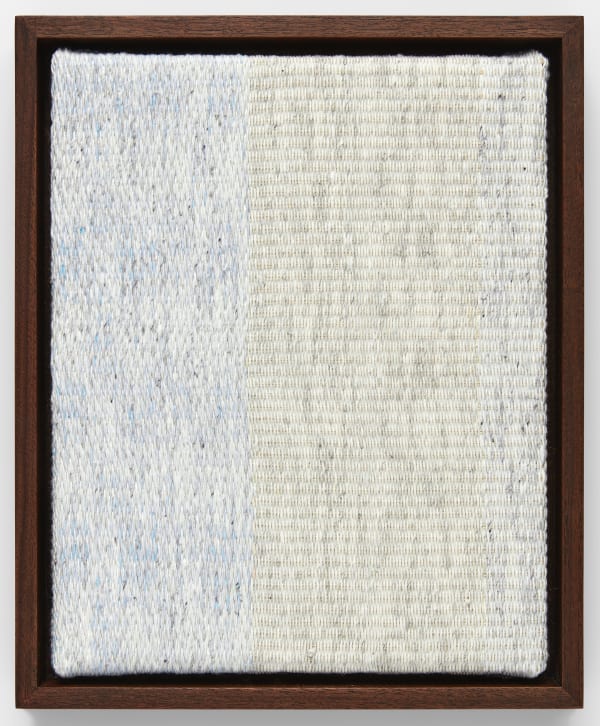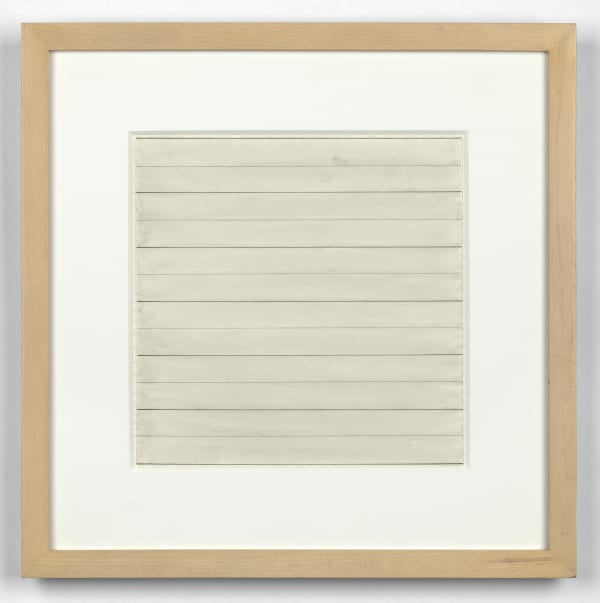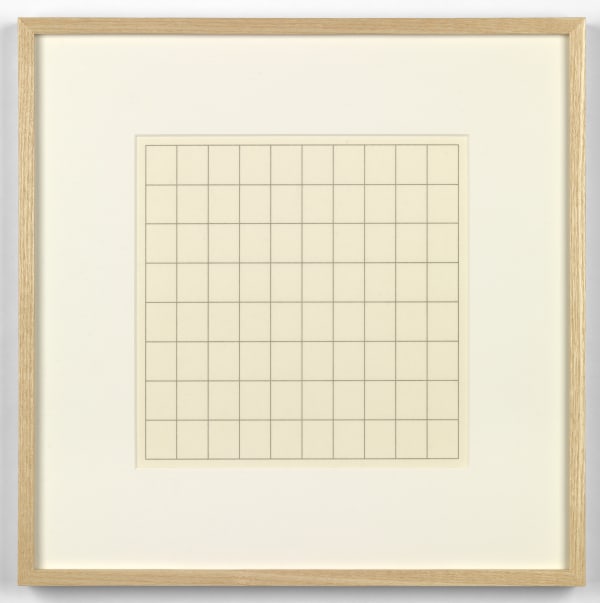'I know of a labyrinth that is but one straight line.'
Jorge Luis Borges, 'Death and the Compass', Ficciones, 1944
Kenturah Davis
Limen
Kenturah Davis’ series, Limen, explores the boundaries of perception, considering ideas at the edge of our visual and linguistic consciousness. By constructing portraiture and weavings from handwritten text on paper, she prompts the viewer to interrogate the role of language in shaping experience. Each black and white portrait resists easy comprehension – Davis’s figures avert their gaze, turn their backs or cover their eyes. On closer examination, the image dissolves, uncovering the complexities of its making. First inscribing the paper with text, creating depressions in its surface, she forms the image by rubbing with pencil, a process that reveals the script with greater clarity. From black holes to astrophysics and time-travel, the texts – legible to varying degrees – approach subjects difficult to grasp. The writings include Davis’ own, as well as those of scientists, novelists and philosophers. Ideas on the fringes of mainstream discourse are also expressed, often those voices marginalised on the basis of racialised and gendered authorship. The intricate weaving accompanying each portrait further conceals its text: words on paper, transformed into thread, are woven into the work’s frame. Within this network of threads, only variations of colour and flecks of ink express the encoded information. Using this textile’s gridded framework to question structure, content and meaning, Davis considers the possibilities and limitations of language in accurately describing ourselves and the world around us.
‘Weaving … [i]t is a very slow and meditative process that has no shortcuts, and it demands a sensitive and delicate touch. This process quite literally merges text and textile.’
Kenturah Davis, Artnet, 2020
Texere

In Conversation: Kenturah Davis & Mary Kelly
Filmed this month, Kenturah Davis and Mary Kelly discuss 'Lines of Thought', drawing out many of the threads running through the exhibition. Featuring the work of both artists alongside that of Agnes Martin, Lines of Thought explores the relationship between language, text, the written word, and the hand-drawn line. Starting with the grid and the influence of Martin on their respective works, the conversation touches on a wide range of ideas - including language, process, history and politics - revealing the sensitive acuity of thought that underpins each artist's practice.
Mary Kelly
‘In every case the concept behind her conceptual art has been unapologetically political and intrinsically personal. She is the godmother of feminist art.’
Nell Frizzell, Vice, 2016

Mary Kelly
Post-Partum Document: Documentation VI (Silver Autone Prints), 1983‘[Kelly’s] handwritten script is not always easily legible, and viewers have the sensation of trying to read illicitly a missive never meant for their eyes as they squint up close to discern its words.’
Jessica Holmes, BOMB magazine, 2017

Mary Kelly
London, 1974, 2017compressed lint, framed
118.1 x 151.1 x 5.1 cm, 46.5 x 59.5 x 2 in
Mary Kelly’s London, 1974 looks to a formative period, both for the artist personally and for the women’s liberation movement. The work comprises two letters from her archive formed in gridded panels of compressed lint – one written by a friend from the commune in Pimlico where Kelly was living, the other from the same friend’s daughter. The 1970s saw new ideas about cohabitation, childcare and domesticity discussed within feminist dialogue – London, 1974 presents differing contemporaneous perspectives on this experience. Each section of the grid is formed by multiple cycles in the artist’s tumble dryer. Presenting a blurred image, Kelly’s unique medium prompts reflection on memory and the passing of time through the slow accumulation of lint. Whilst the text of the letters is difficult to read in parts, putting distance between the viewer and the authors, the replication of handwriting elicits a more direct, emotional relationship. Created several decades after the event, London, 1974 (2017) questions what defines that moment in feminist history and what constitutes its relationship to the present.
‘It is through [Kelly's use of] lint – this ubiquitous, quotidian material – that history becomes a tumultuous cycle of images, that is not so much repetitive as it is relentless, producing not only substance and residue, or memory and uncertainty, but also revolutionary potential and matter.’
Stephanie Bailey, Artforum, December 2014

Agnes Martin

graphite and ink on paper mounted on board
signed, titled and dated "'the peach' '64, a. martin'"
30.5 x 30.5 cm, 12 x 12 in
‘Martin’s work is somewhat akin to the sort of text that Roland Barthes described as “ourselves writing.” Barthes was describing the kind of text […] that jump-starts readers’ expectations and demands that they take an active role in the construction of meaning.’
Jane Yong Kim, LA Review of Books, 2015

'They're just horizontal lines. There's not any hint of nature. And still everybody responds, I think.'
Agnes Martin, 1995
On a Clear Day
Agnes Martin’s first print series, On a Clear Day, is composed of 30 screen prints on handmade paper. Identical in size, each presents a square made up of horizontal – and sometimes vertical – grey lines, varying in number. Making reference to the number of days in a month, this body of work is her first to explore notions of duration and seriality. Adopting a rigorously pared back visual language, Martin uncovers its endless compositional possibilities, together with its expressive potential – each subtle variation echoes loudly, reverberating in relation to the series as a whole. On a Clear Day was executed at a significant moment in the artist’s career. Following her departure from New York in 1967, she stopped working altogether. Leading her back to painting, these prints mark a return to art-making after a six-year hiatus. By expressing an emotion as pure and exhilarating as a bright, sunny morning, On a Clear Day communicates the serenity that attends clarity of vision, physical and spiritual.
‘Grander in conception than any of Martin's paintings, On a Clear Day condenses through multiplication thirty ways of constructing a grid, of expressing happiness, beauty, freedom, and the impossibility of, though yearning for, perfection.’
Kevin Salatino, Curator of Prints and Drawings, LACMA, 2008























